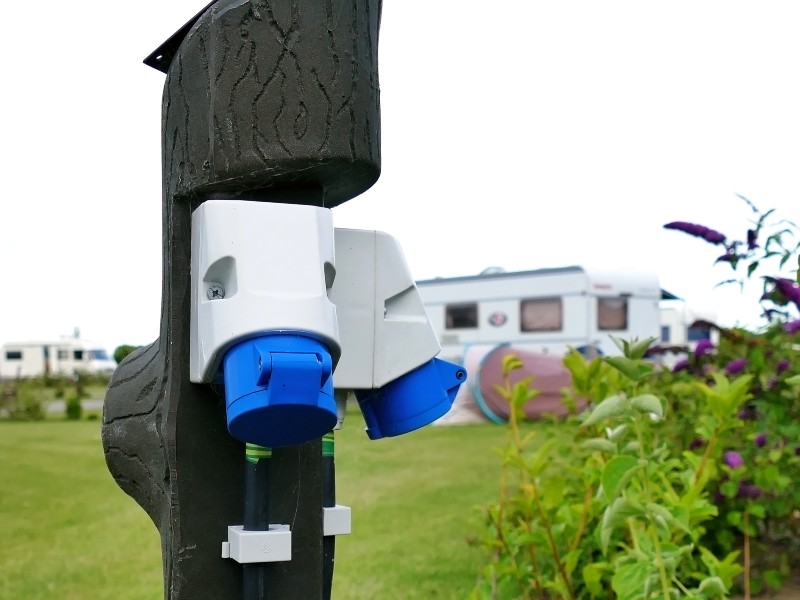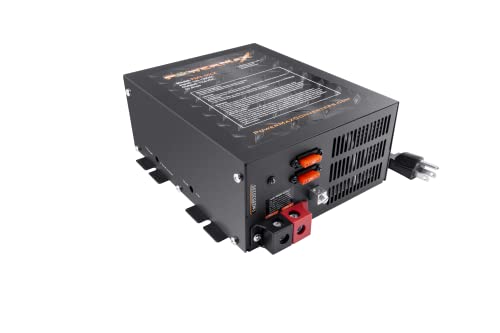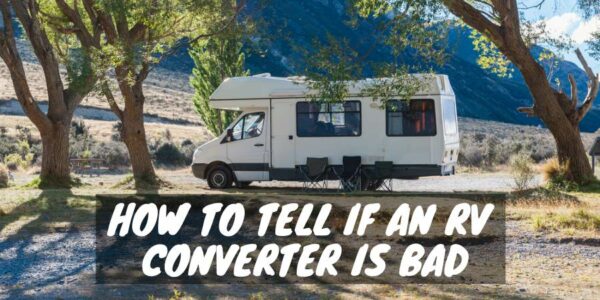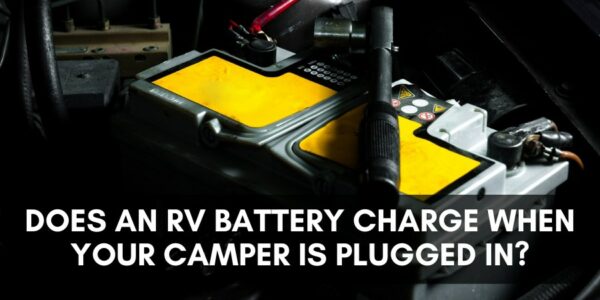Owning an RV means learning about the equipment that helps all your camper’s components to operate smoothly, starting with the importance of the converter and battery charger.
What are these two items, and what is the difference between an RV converter vs. an RV battery charger?
A converter will change electrical power from 120-volt to 12-volt to keep specific RV appliances and lights running, while the battery charger will keep your RV house battery charged.
However, there’s much more to know about how the converter and battery charger work in tandem to keep your RV functioning, so I put the details in this guide.
Once you understand how these two critical RV components work, you’ll be able to quickly troubleshoot RV electrical issues and also keep your motorhome, travel trailer, or the fifth wheel safer!
The Basics of RV Power Supply
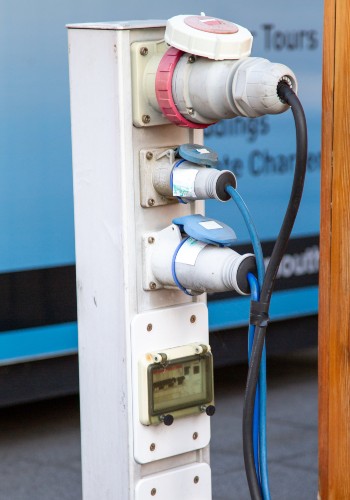
Before we get into the differences between an RV battery charger and an RV converter, I must first explain the various power supplies inside most recreational vehicles and how integral they are for everything to function correctly.
Most RVs rely on 110-volt electricity that you access by plugging into shore power, 12-volt power stored in the RV house batteries, and in many instances, the third option for appliances to run is through propane.
Propane and 12-volt power are necessary for RVers to use their camper’s appliances, lights, and other components when off-grid camping or during power outages at RV parks or campgrounds.
RV appliance design allows them to run off a combination of different power supplies. For example, the RV refrigerator will operate off 110-volt electricity or propane but will always require 12-volt power for the control panel to function.
This mixing of power needs can become very confusing to new RV owners, and to be honest, is a common source of frustration among RVers with years of experience too!
In general, the best recreational vehicles offer owners the chance to camp in comfort while on shore power and when off the grid.
However, the only way to keep your battery bank and RV appliances and lights running properly in both situations is to have a converter and battery charger inside your camper.
In the next section, I explain the differences between a converter vs. a battery charger and what important features they should offer to keep your RV safe and operating correctly.
The Difference between an RV Battery Charger vs Converter
More confusion occurs when explaining the differences between a converter and battery charger in an RV because, most often, the converter has a battery charging feature within the unit.
To help you understand how these units function, let me detail what each does, what it looks like, and where you’ll find it within your recreational vehicle.
What is an RV Battery Charger?
- [All in One, Keep your battery charged and your car ready to go] Battery Charger…
- [Enjoy Precision Charging, Your car deserves the best] Using a backlit LCD, the…
- [Restore your Battery, Don’t let a dead battery ruin your plans] Built-in…
- [8 Charging Protection, Never get stranded again] The charging cable contains…
- [Intelligent Memory] The Car Battery Charger mode has a memory function. After…
An RV battery charger is not a free-standing appliance you plug into an outlet or generator and attach to your RV house battery using alligator clips. The unit is not what most people think of when charging up a dead car or golf cart battery.
The battery charger within an RV is part of the entire electrical system, with wires that connect the main power panel to the 12-volt battery (or batteries).
The charger allows a safe current of electricity to flow to the battery to hold the power until it’s needed.
The only job of the battery charger is to maintain the battery’s power level. It doesn’t provide a way for the battery to send that power it’s holding out to any RV lights or appliances.
A compatible charger for RVs with a solar power system takes power generated from the panels and converts it to keep your RV batteries charged. A solar charger is typically not part of a standard RV setup and is an extra component that works along with or in place of the standard RV house battery charger.
As stated above, most recreational vehicles have the battery charger as part of the converter system, with many sold as a converter/charger. However, not all converter/chargers work the same way, with some models much safer and more efficient for charging your house battery.
Some RVs have a battery charger within the converter that allows electricity to flow at the correct level to the battery. But unfortunately, these older or inexpensive charger units don’t have the sensors to reduce or stop the electrical current to the battery once the battery is nearing capacity.
If the power keeps flowing to the battery once it’s full, it can overheat and damage the battery or even cause a fire.
Modern RVs should have an “intelligent” converter/charger. These units offer charging stages that will alter the current flowing to the battery to keep it full without allowing it to overcharge, as well as other battery protection features.
This type of smart converter/charger is the only one to have in a recreational vehicle, as they are much safer and will extend the life of your RV house batteries. If you find your RV has a continually charging type of converter, it’s best to replace it with a multi-stage unit as soon as possible.
Most battery chargers are within the converter system inside your RV power panel. The unit is often next to or underneath the RV circuit breakers or mounted inside a storage compartment near the house battery bank.
What is an RV Converter?
- Controlled, Quiet, Cool Operation – This converter operates quietly and…
- Wide voltage range – The PowerMax converter is a flexible power source suitable…
- Certified safety – Rest easy with the PowerMax converter, a trusted choice for…
- Reverse Battery Protection – With the built-in reverse battery protection, you…
- Replacement for WF-9800 Series – This highly efficient converter is designed to…
An RV converter is a way your camper will take the 120-volt power coming in from a campground or residential power pedestal and convert some of that energy into 12-volt power that will operate various RV components such as:
- Lights
- 12-volt outlets
- Igniters for furnace or water heater
- Refrigerator or air conditioner display panel
- Television
- Fans
- Water pump
- Digital thermostat and RV control center
In addition to the above RV devices and appliances, the converter will almost always provide the 12-volt power necessary to charge your RV house battery bank.
The size and type of converter in a motorhome or travel trailer will depend on your camper’s power needs.
For example, if you have a 50-amp fifth wheel, it will likely have a 55-65 amp converter. On the other hand, my mid-size 30-amp Class C motorhome has a 35-amp converter.
However, some RVs have a large battery bank to provide extra power during long boondocking trips and require a 70-amp or more converter to keep everything running as it should and the batteries ready for action.
The converter sets within your RV power panel, which is often behind a small access door on the interior of your camper, but sometimes it’s in an outside storage bay near the house batteries.
The converter is a metal box with components to alter the electrical current. The converter connects to the main breaker box to power the unit, and it has wires that run to a control board. The control board or “fuse block” has wires coming from the converter that powers the board, and the board then has connection ports for all the wires that feed the 12-volt circuits.
Above each circuit is a place to insert a fuse that will blow if there are issues with the flow of electricity. A converter/charger control board will have input and output wires that go to the house battery bank.
Also, on the board, you may find a reset button and an LED light that will flash intermittently to indicate the battery charge status. Many high-quality converter/chargers will also have a remote display that you can mount in an easy-to-read location that provides a digital readout of your battery status.
This RV converter setup is typical, but the look of each will vary depending on brand and size. Top manufacturers of RV converters are:
- Progressive Dynamics
- PowerMax
- RecPro
- IOTA Engineering
RV converters do go bad, but luckily, the cost to replace the unit is around $500 or less, which isn’t a bad investment for all it does to help your RV work properly.
RV Converter vs RV Inverter
- 【2000w Power Continuous】Modified Sine Wave Inverter converts DC 12volt to AC…
- 【More Widely Used】Features multiple types AC 110-120V Outlets and DC 5V 2.4A…
- LCD Display And Remote Controller】Coming with a LCD Display and 15 ft Remote…
- 【Soft Start and Protection】Soft Start tech and Isolated Input/Output design…
- 【What You Will Get】A 2000w modified sine wave power inverter,a 15ft remote…
To help clarify all the possible power components within your RV, I need to mention what an inverter does, which isn’t the same as a converter.
An RV inverter is a unit that takes the 12-volt power stored in your house batteries and changes it to 110-volt power so you can use your RV air conditioner or other appliances that require a strong electrical draw when you aren’t on shore power.
Inverters are slightly more expensive than converters, and not all RVs come with one standard. The need to add an inverter and more batteries is a personal choice based on your camping power needs and style.
Want to Connect With a Community of Over 1,078 RV Enthusiasts?
The size of the inverter is directly related to the number of house batteries and the amount of wattage you need to run your RV 110-volt appliances.
For people who love to camp off-grid, having a robust battery bank and a powerful inverter in their RV is crucial to enjoying full use of the camper, especially during summer when you want to run your air conditioner.
If you do feel the need to install an inverter in your RV, look for one that produces pure sine wave power that is better for sensitive electronic equipment like computers, TVs, or stereos.
Cheaper inverters will produce modified sine waves, which is fine for some applications like running the RV water pump. However, it will still slightly reduce performance and could cause damage over time.
Knowing the Difference Between Your RV Inverter and Converter (Video)
How to Know if an RV Battery Charger or Converter is Bad?
There are signs that an RV battery charger or converter isn’t working right, which will help you determine what you need to do to fix the problem before it ruins your camping plans.
A bad battery charger will:
- Not charge the batteries enough or at all
- Overcharge the batteries causing heat and possible fire or explosion
If the batteries are not charging correctly, you’ll find that the lights, fans, or other 12-volt devices dim quickly or don’t come on at all when disconnected from shore power.
You may also notice an odd sulfur-like smell or excessive warmth emanating from your battery compartment from them overheating. If you have this type of problem, immediately disconnect your battery bank from the charger.
It’s common for a faulty battery charger to ruin your RV house battery, which means you’ll need to have it tested and replaced if it isn’t holding charge.
Signs of a bad converter include:
- Flickering or dimming lights in the RV
- Fluctuation of power when running a vent fan
- RV fridge having a hard time maintaining a consistent temperature
- Cooling fan inside the converter isn’t running
- Batteries are not charging
- No power at all in the RV
If you check the shore power pedestal and all your circuit breakers and fuses for trips and you don’t see any issues, chances are the converter is bad and will need repair or replacement.
I have replaced my old RV converter/charger with a newer and safer version, but it isn’t always a DIY project.
If you’re uncomfortable dealing with electricity, always hire a professional to avoid miswiring the converter, which could lead to a fire or blowing out all your RV appliances.
RV Converter, Replacing It! How to Know It’s Bad and How to Replace It! (Video)
Final Thoughts
An RV battery charger keeps your house battery bank full, so you can use it to power lights and other 12-volt appliances while boondocking.
An RV converter changes 120-volt electricity to 12-volt electricity, so you can plug into shore power at an RV park or campground and still enjoy using all your RVs 12-volt components.
I hope this guide explains the differences between a battery charger and vs. converter and that you use the information to locate the components inside your RV to ensure they are working correctly.
The more you know about how your RV power system works, the more prepared you’ll be when it’s time to troubleshoot electrical issues. The information above is also helpful when upgrading an old or damaged battery charger or converter.
With a suitable converter and battery charger, your RV will be safer, and you’ll have all the 110-volt and 12-volt power you need on every camping trip!
"Man cannot discover new oceans unless he has the courage to lose sight of the shore."
-- Andre Gide

